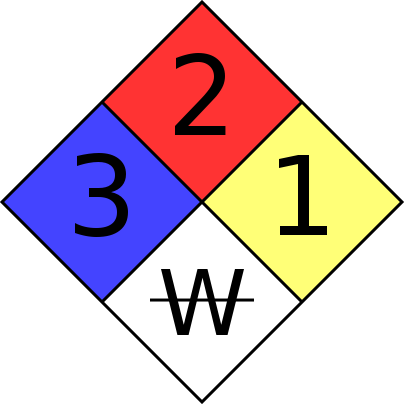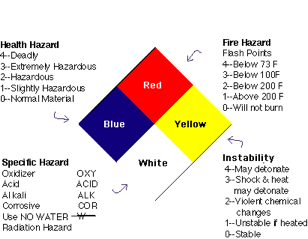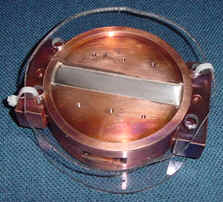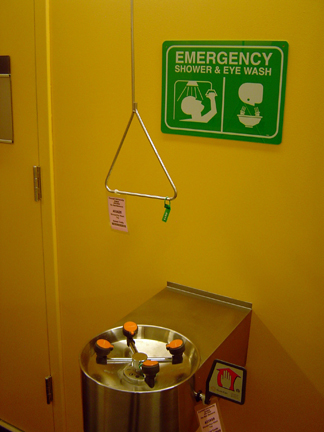You are here: CLASSE Wiki>Safety/Handbook Web>ChemicalSafety (27 Aug 2021, RigelLochner)Edit Attach
Chemical Safety
Chemical Overview
OSHA "Right to Know" and Lab Chemical Safety laws require all employers to provide information and training to employees to ensure that they are apprised of the hazards of chemicals present in their work area. The EPA requires us to dispose of our chemical waste in an environmentally responsible way; Cornell EHS assists us in doing so. The purpose of this chapter is to provide information on how to safely and responsibly purchase, store, use, and dispose of chemicals and where to find the resources you will need. CLASSE follows the federally mandated rules spelled out in the OSHA Hazard Communication Standard and those of the Cornell EHS Chemical Hygiene Plan; both are available in hard copy in the business offices of both Wilson (Room 305) and Newman (Room 134) laboratories (in addition to the links above). The plan stipulates that:- Training programs will prepare employees to work safely with chemicals
- Labels on incoming containers must not be removed or defaced
- Safety Data Sheets (SDS) that are received with the products will be maintained and available to lab personnel
- Information will identify the hazards associated with a chemical
Chemical Training
If you and your supervisor agree your work involves significant use of chemicals, you may be asked to take one or more training sessions either at EHS, CLASSE, or both. When we must use substantial quantities of dangerous chemicals such as in cleaning and etching high vacuum components and niobium super-conducting RF cavities, we use special facilities to do this work safely in our Chem Room in Newman Lab. Anyone who uses or works at CLASSE must receive special training from a CLASSE Chem Room Technician.Safety Data Sheets
Safety Data Sheets (SDS) provide information about chemicals and other products. Each sheet includes information about one product's ingredients, usage, hazards and emergency procedures. Supervisors must provide any relevant SDS as part of preparing an employee or student to use a new product or chemical. Workers must read them to be prepared to use the product safely. As an example, examine this sulfuric acid SDS. Note that SDS do not all look alike because different manufacturers provide them. SDS binders are located in the first floor receiving area in Wilson Lab and in the business office of Newman (Room 134) Lab. Smaller sets of chemicals commonly used in those locations are kept in the Newman chemical room (B50D) and some of the shops. When looking up a product, try the brand name and/or the product type. For example, Acme Ant Gel may be under Acme and/or under Ant Gel. Cornell EHS provides links to many searchable SDS websites on its SDS page. You can also locate them via web search engine, or at the SIRI site or the local CHESS site. If you cannot find the SDS you need, EHS can get it for you upon request. After reading an SDS and learning about the hazards associated with a chemical or other product, be sure to discuss with your supervisor, or the area supervisor, your own plans for using the product and what precautions you plan to take. If you plan to use a chemical you've used before, but in a different location, please check with the supervisor of that area in order to ensure safety. If you have not used the chemical before, you or your supervisor must discuss your plans with the CLASSE Safety Director.Chemical Warning Labels
OSHA requires that manufactured chemical products come labeled with the chemical name, hazard warnings, handling precautions, and manufacturer's name and address. Leave these labels in place and do not obscure or deface them. There is a standard for such labels established by the NFPA (National Fire Protection Association). Quoting from the NFPA 704 FAQ on what is sometimes known as "the NFPA Diamond": "The standard provides a readily recognized, easily understood system for identifying specific hazards and their severity using spatial, visual, and numerical methods to describe in simple terms the relative hazards of a material. It addresses the health [left, blue], flammability [top, red], instability [right, yellow], and related [bottom, white] hazards that may be presented as short-term, acute exposures that are most likely to occur as a result of fire, spill, or similar emergency." Each colored diamond is numbered as 0 (no hazard), 1, 2, 3, or 4 (most hazardous). An example appears at right and a guide is shown below.
There is a standard for such labels established by the NFPA (National Fire Protection Association). Quoting from the NFPA 704 FAQ on what is sometimes known as "the NFPA Diamond": "The standard provides a readily recognized, easily understood system for identifying specific hazards and their severity using spatial, visual, and numerical methods to describe in simple terms the relative hazards of a material. It addresses the health [left, blue], flammability [top, red], instability [right, yellow], and related [bottom, white] hazards that may be presented as short-term, acute exposures that are most likely to occur as a result of fire, spill, or similar emergency." Each colored diamond is numbered as 0 (no hazard), 1, 2, 3, or 4 (most hazardous). An example appears at right and a guide is shown below.

Common Chemicals and Hazardous Materials
No matter how harmless a chemical may appear, it can be dangerous. More accidents happen with common chemicals than with chemicals used for special purposes. Some examples of the hazards involving the following chemicals that are commonly used at the Lab: Methanol, isopropanol, ethanol, and acetone are all common chemicals that are used throughout CLASSE for cleaning equipment as well as other purposes. All of them are flammable and can be explosive if used improperly. Excessive exposure by inhalation, skin contact, or ingestion can cause serious health consequences. They should be used in either a fume hood or a well ventilated area. Gloves and eye protection are required when working with these chemicals. None of these are drain-disposable. All must be treated as hazardous waste and disposed of by Cornells EHS. Lead metal, unlike the "lead" in leaded gasoline, cannot be absorbed through the skin. However, it is harmful if inhaled or ingested because it gets into the blood stream. It is a cumulative poison that may cause decreased physical fitness, fatigue, sleep disturbance, headaches, abdominal pain, kidney damage, brain damage, and other severe conditions. Never cut, sand or machine lead bricks without special training. Always wear gloves (leather or rubber) and protective footwear when handling lead and wash your hands afterward. Sweep up any chips created by machining lead and give them to the rigging crew or EHS for recycling. Beryllium: Beryllium is a silver-gray metal that has been produced for various industrial uses since the late 1950s. Inhalation of beryllium particles can cause a serious illness in certain people. This illness is chronic beryllium disease, or CBDan irreversible and sometimes fatal scarring of the lungs. Do not touch Beryllium-containing components with bare hands. Articles that may contain Beryllium include (but are not limited to):
Articles that may contain Beryllium include (but are not limited to): - X-ray transparent containers, in particular as a part of specimen holders.
- X-ray windows on detectors (Bicron, Amptek), or beamline components such as flight tubes.
- High heatload compatible components.
- Ceramics used in electronics devices and other equipment.
- Springs, switches and relays.
- High-strength non-sparking tools.
Protective Clothing
Every chemical is potentially hazardous, so take simple precautions if you use any. Do not wear contact lenses, shorts, skirts, or open-toed shoes. Restrain long hair. You must wear appropriate protection when you work with chemicals. Possible protective clothing you should use includes aprons, lab coats, boots, acid gloves, safety glasses, and face shields. After using reusable items, such as acid gloves, wash them thoroughly for the protection of the next user.Eye Wash and Shower
 Eye washes and/or showers are located at several locations in Wilson Lab, Newman Lab, and the Physical Sciences Building. If you are working with hazardous chemicals, read the SDS to find out if eyewashes and showers might be useful in the event of a spill, and familiarize yourself with the nearest such station's location and operation. The wearing of appropriate protective clothing should, in most cases, prevent the need for such situations.
Eye washes and/or showers are located at several locations in Wilson Lab, Newman Lab, and the Physical Sciences Building. If you are working with hazardous chemicals, read the SDS to find out if eyewashes and showers might be useful in the event of a spill, and familiarize yourself with the nearest such station's location and operation. The wearing of appropriate protective clothing should, in most cases, prevent the need for such situations.
Chemical Purchase and Disposal
If you plan to purchase any chemicals, keep in mind that disposal of both unused and waste chemicals costs money. Purchase only the quantities of chemicals you need. These chemicals have hazards associated with them. Obtain, read, and understand the SDS for the chemical before you purchase it. Use that information to plan and prepare to use it safely. Discuss your plan with your supervisor and a Chem Room Technician, or the CLASSE Safety Director. Give copies of the SDS to anyone who will be working with it and put a copy in the SDS binders. As the purchaser, you are responsible for storing chemicals safely and labeling them correctly. Never leave chemicals in unlabeled containers. Aside from presenting unknown dangers to those working around the chemicals, identification and disposal of the chemicals involves a costly analytical process. Disposal of chemicals requires environmental responsibility. Never pour anything down a sink or throw anything away before checking the chemical's SDS and Section 7 of the Cornell Chemical Hygiene Plan (available in the Newman and CHESS Chem Rooms, the Business Office, and near the Wilson loading dock). Chemicals clearly identified as non-hazardous in the plan should be marked "Non-Hazardous" and put directly in the dumpster. Custodians are not allowed to dispose of any chemical. For hazardous chemicals that must be disposed of by EHS, follow the EHS instructions: obtain a Cornell Hazardous Waste tag from the Newman or Wilson chemical rooms or by requesting one from this email address, fill it out (leaving top copy with the waste) and make the pickup request online from EHS. Store the chemical in secondary containment with a copy of the SDS nearby. EHS should pick it up within 3 days. If you still have questions, check with your supervisor, the Newman or CHESS Chemical Room Technicians, the CLASSE Safety Director, or EHS. Procedures for purchase and disposal of chemicals (and compressed gases) are different for the Physical Sciences Building. All materials not delivered through the building loading dock must be registered with the Safety Manager and bar-coded. Empties are dealt with by placing the bar code on this form and sending it as instructed on that form.The Chemical Room (Newman B50D)
Only employees who have the permission of their supervisor, have been specifically trained, and have received permission from a Chemical Room Technician may use the chemical room at Newman Lab. You must wear eye protection to enter the Newman Chem Room, and may enter only if either (a) a trained staff member is present, or (b) you have the appropriate training specific to this space. Work in the chemical room is limited to established procedures with specific chemicals. Acids used in large quantities include nitric, phosphoric, hydrofluoric, and sulfuric acids. Solvents used in large quantities include methanol, acetone, and isopropanol. Choose the least hazardous chemical you can that will do the job. Purchase or use only what you need. Before you start, become familiar with the information on the Safety Data Sheets. Do not put yourself or others at unnecessary risk.End of Chemical Safety
Edit | Attach | Print version | History: r16 < r15 < r14 < r13 | Backlinks | View wiki text | Edit wiki text | More topic actions
Topic revision: r16 - 27 Aug 2021, RigelLochner
-
 Safety/Handbook Web
Safety/Handbook Web
-
 Create New Topic
Create New Topic
-
 Index
Index
-
 Search
Search
-
 Changes
Changes
-
 Notifications
Notifications
-
 RSS Feed
RSS Feed
-
 Statistics
Statistics
-
 Preferences
Preferences
- Webs
-
 ACC
ACC
-
 ACL
ACL
-
 Bunch
Bunch
-
 Private
Private
-
 BusinessOffice
BusinessOffice
-
 CBB
CBB
-
 NSF
NSF
-
 CBETA
CBETA
-
 CESR
CESR
-
 Private
Private
-
 CHESS
CHESS
-
 FMB
FMB
-
 Maia
Maia
-
 XIMG
XIMG
-
 CHEXS
CHEXS
-
 CLASSE
CLASSE
-
 Inventory
Inventory
-
 Communications
Communications
-
 CLEO
CLEO
-
 AC
AC
-
 Administration
Administration
-
 RunMan
RunMan
-
 SW
SW
-
 CMSPhase2MREFC
CMSPhase2MREFC
-
 Computing
Computing
-
 Blogs
Blogs
-
 Newsletter
Newsletter
-
 Obsolete
Obsolete
-
 Private
Private
-
 Cosmology
Cosmology
-
 Private
Private
-
 DarkPhoton
DarkPhoton
-
 ERL
ERL
-
 Private
Private
-
 EngineeringDesignDrafting
EngineeringDesignDrafting
-
 G2
G2
-
 HEP
HEP
-
 DBSWorkshop
DBSWorkshop
-
 SWIG
SWIG
-
 HLLHCCMSMREFC
HLLHCCMSMREFC
-
 HMF
HMF
-
 HumanResources
HumanResources
-
 Private
Private
-
 ILC
ILC
-
 Americas
Americas
-
 CesrTA
CesrTA
-
 Proposal
Proposal
-
 DampingRings
DampingRings
-
 AreaLeaders
AreaLeaders
-
 CTA09
CTA09
-
 ILCDR06
ILCDR06
-
 ILCDR07_KEK
ILCDR07_KEK
-
 ILCDR08
ILCDR08
-
 S3TaskForce
S3TaskForce
-
 Private
Private
-
 CesrTA
CesrTA
-
 WWS
WWS
-
 MacCHESS
MacCHESS
-
 Main
Main
-
 People
People
-
 PhotocathodeBrightBeams
PhotocathodeBrightBeams
-
 REU
REU
-
 Private
Private
-
 SRF
SRF
-
 PCsrfcn1
PCsrfcn1
-
 Safety
Safety
-
 Handbook
Handbook
-
 Private
Private
-
 ExternalResources
ExternalResources
-
 Sandbox
Sandbox
-
 TestWeb
TestWeb
-
 Testauth
Testauth
-
 System
System
-
 Theory
Theory
-
 Communications
Communications
-
 Documents
Documents
-
 Phase2MREFC
Phase2MREFC
-
 WebDev
WebDev
-
 Private
Private
-
 XLEAP
XLEAP
 Copyright © by the contributing authors. All material on this collaboration platform is the property of the contributing authors.
Copyright © by the contributing authors. All material on this collaboration platform is the property of the contributing authors. Ideas, requests, problems regarding CLASSE Wiki? Send feedback



